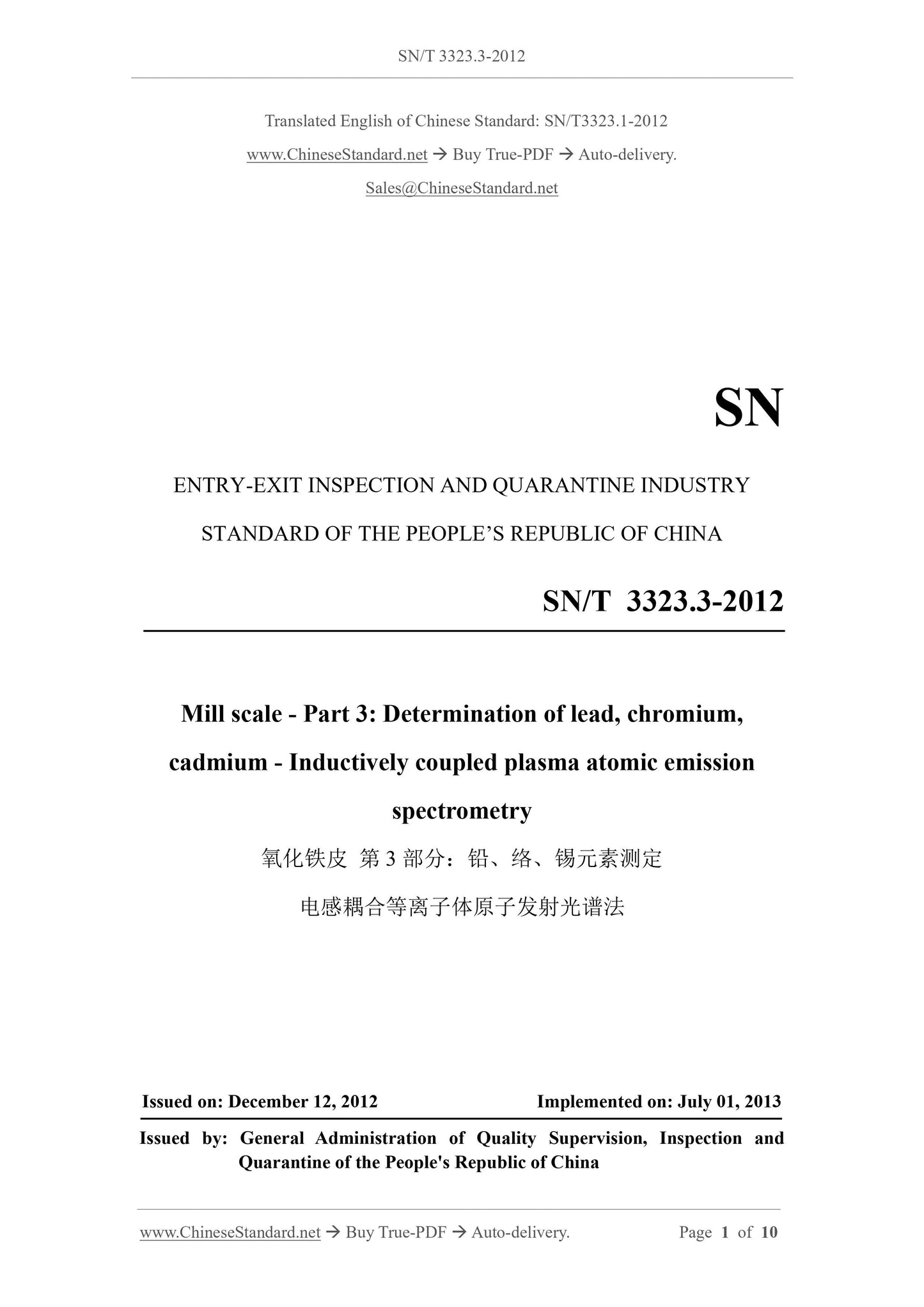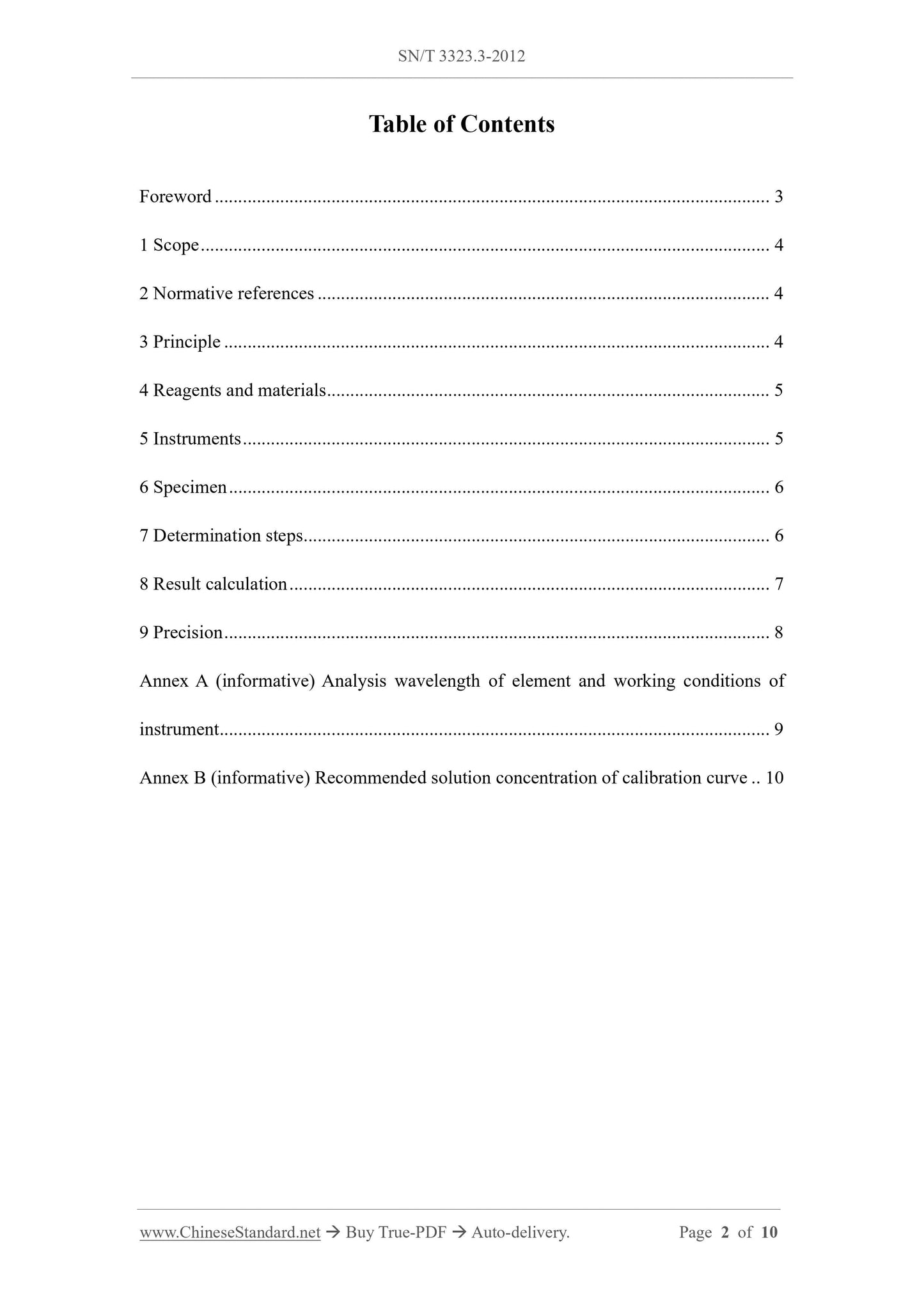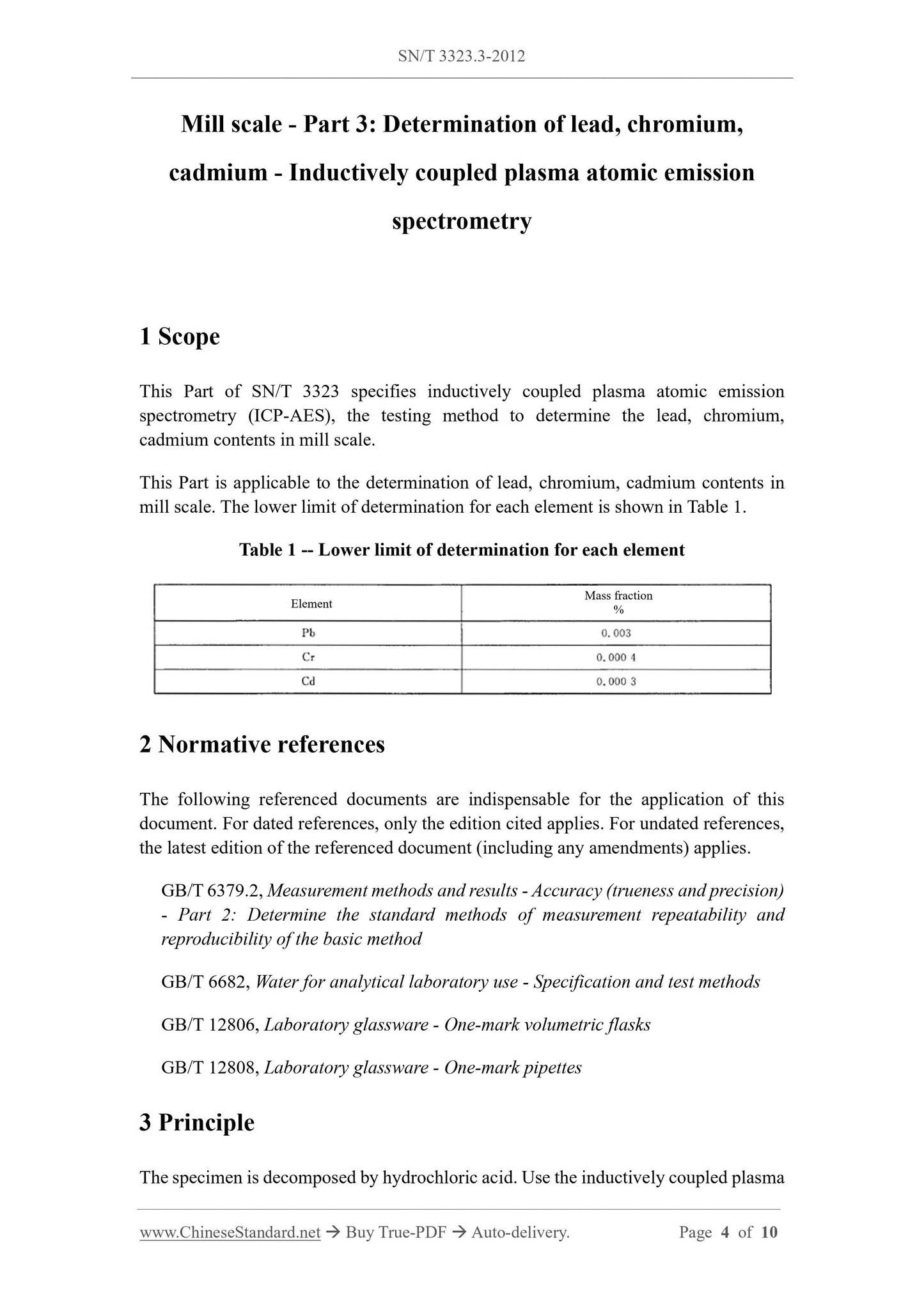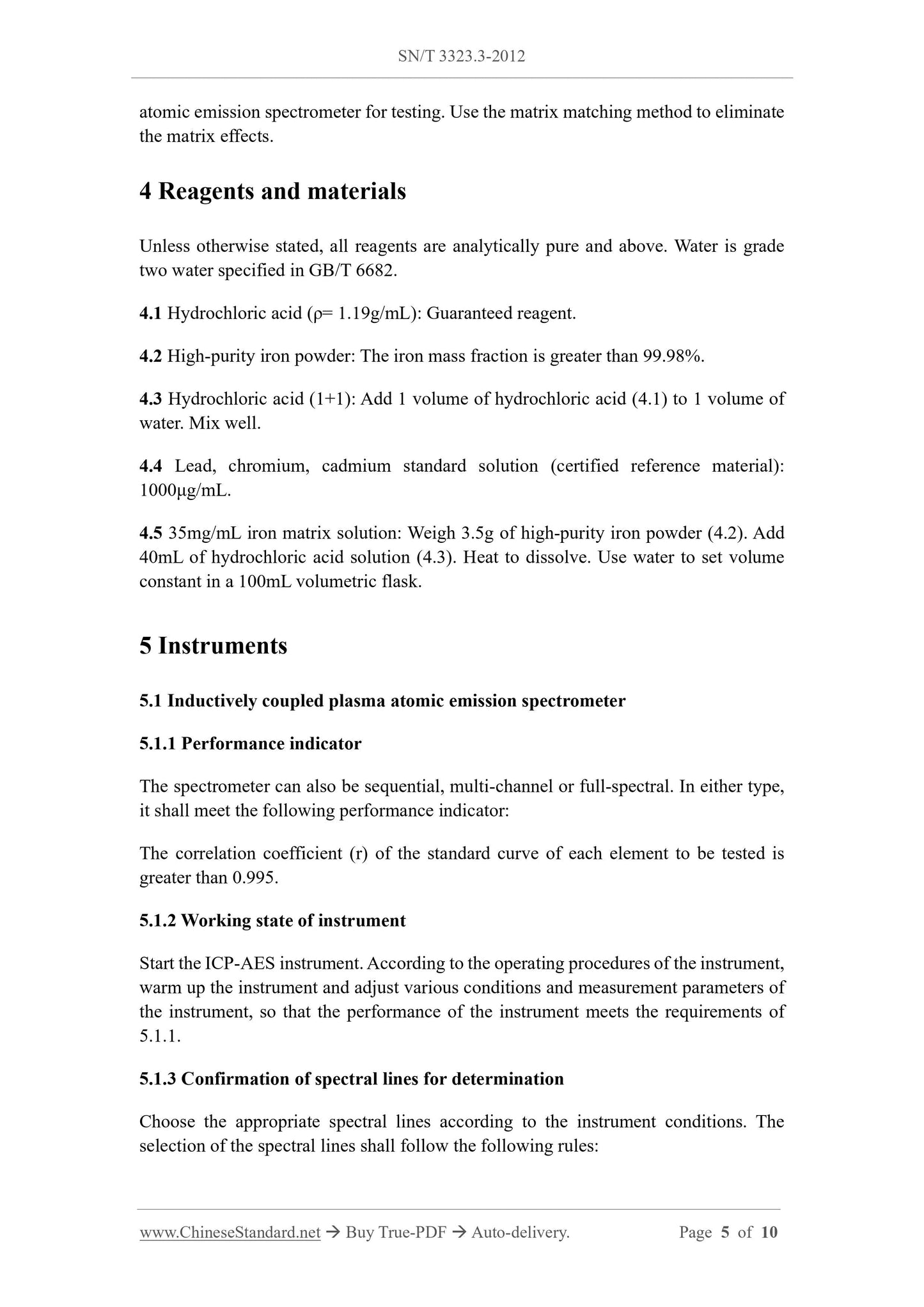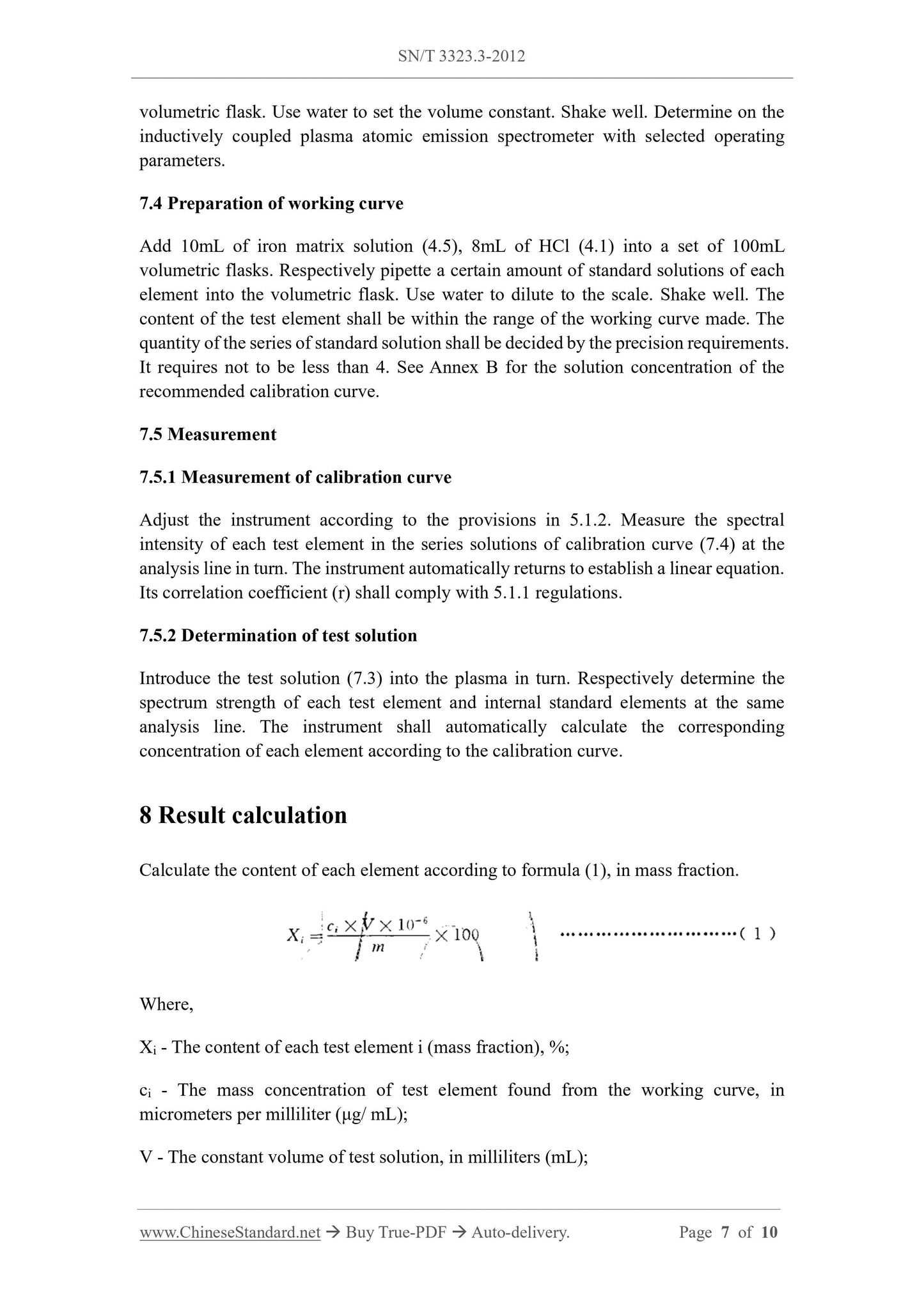1
/
of
5
PayPal, credit cards. Download editable-PDF & invoice in 1 second!
SN/T 3323.3-2012 English PDF (SN/T3323.3-2012)
SN/T 3323.3-2012 English PDF (SN/T3323.3-2012)
Regular price
$215.00 USD
Regular price
Sale price
$215.00 USD
Unit price
/
per
Shipping calculated at checkout.
Couldn't load pickup availability
Delivery: 3 seconds. Download true-PDF + Invoice.
Get QUOTATION in 1-minute: Click SN/T 3323.3-2012
Historical versions: SN/T 3323.3-2012
Preview True-PDF (Reload/Scroll if blank)
SN/T 3323.3-2012: Mill scale. Part 3: Determination of lead, chromium, cadmium. Inductively coupled plasma atomic emission spectrometry
SN/T 3323.3-2012
ENTRY-EXIT INSPECTION AND QUARANTINE INDUSTRY
STANDARD OF THE PEOPLE’S REPUBLIC OF CHINA
Mill scale - Part 3: Determination of lead, chromium,
cadmium - Inductively coupled plasma atomic emission
spectrometry
ISSUED ON: DECEMBER 12, 2012
IMPLEMENTED ON: JULY 01, 2013
Issued by: General Administration of Quality Supervision, Inspection and
Quarantine of the People's Republic of China
Table of Contents
Foreword ... 3
1 Scope ... 4
2 Normative references ... 4
3 Principle ... 4
4 Reagents and materials ... 5
5 Instruments ... 5
6 Specimen ... 6
7 Determination steps ... 6
8 Result calculation ... 7
9 Precision ... 8
Annex A (informative) Analysis wavelength of element and working conditions of
instrument ... 9
Annex B (informative) Recommended solution concentration of calibration curve .. 10
Mill scale - Part 3: Determination of lead, chromium,
cadmium - Inductively coupled plasma atomic emission
spectrometry
1 Scope
This Part of SN/T 3323 specifies inductively coupled plasma atomic emission
spectrometry (ICP-AES), the testing method to determine the lead, chromium,
cadmium contents in mill scale.
This Part is applicable to the determination of lead, chromium, cadmium contents in
mill scale. The lower limit of determination for each element is shown in Table 1.
Table 1 -- Lower limit of determination for each element
2 Normative references
The following referenced documents are indispensable for the application of this
document. For dated references, only the edition cited applies. For undated references,
the latest edition of the referenced document (including any amendments) applies.
GB/T 6379.2, Measurement methods and results - Accuracy (trueness and precision)
- Part 2: Determine the standard methods of measurement repeatability and
reproducibility of the basic method
GB/T 6682, Water for analytical laboratory use - Specification and test methods
GB/T 12806, Laboratory glassware - One-mark volumetric flasks
GB/T 12808, Laboratory glassware - One-mark pipettes
3 Principle
The specimen is decomposed by hydrochloric acid. Use the inductively coupled plasma
Element Mass fraction %
atomic emission spectrometer for testing. Use the matrix matching method to eliminate
the matrix effects.
4 Reagents and materials
Unless otherwise stated, all reagents are analytically pure and above. Water is grade
two water specified in GB/T 6682.
4.1 Hydrochloric acid (ρ= 1.19g/mL): Guaranteed reagent.
4.2 High-purity iron powder: The iron mass fraction is greater than 99.98%.
4.3 Hydrochloric acid (1+1): Add 1 volume of hydrochloric acid (4.1) to 1 volume of
water. Mix well.
4.4 Lead, chromium, cadmium standard solution (certified reference material):
1000μg/mL.
4.5 35mg/mL iron matrix solution: Weigh 3.5g of high-purity iron powder (4.2). Add
40mL of hydrochloric acid solution (4.3). Heat to dissolve. Use water to set volume
constant in a 100mL volumetric flask.
5 Instruments
5.1 Inductively coupled plasma atomic emission spectrometer
5.1.1 Performance indicator
The spectrometer can also be sequential, multi-channel or full-spectral. In either type,
it shall meet the following performance indicator:
The correlation coefficient (r) of the standard curve of each element to be tested is
greater than 0.995.
5.1.2 Working state of instrument
Start the ICP-AES instrument. According to the operating procedures of the instrument,
warm up the instrument and adjust various conditions and measurement parameters of
the instrument, so that the performance of the instrument meets the requirements of
5.1.1.
5.1.3 Confirmation of spectral lines for determination
Choose the appropriate spectral lines according to the instrument conditions. The
selection of the spectral lines shall follow the following rules:
volumetric flask. Use water to set the volume constant. Shake well. Determine on the
inductively coupled plasma atomic emission spectrometer with selected operating
parameters.
7.4 Preparation of working curve
Add 10mL of iron matrix solution (4.5), 8mL of HCl (4.1) into a set of 100mL
volumetric flasks. Respectively pipette a certain amount of standard solutions of each
element into the volumetric flask. Use water to dilute to the scale. Shake well. The
content of the test element shall be within the range of the working curve made. The
quantity of the series of standard solution shall be decided by the precision requirements.
It requires not to be less than 4. See Annex B for the solution concentration of the
recommended calibration curve.
7.5 Measurement
7.5.1 Measurement of calibration curve
Adjust the instrument according to the provisions in 5.1.2. Measure the spectral
intensity of each test element in the series solutions of calibration curve (7.4) at the
analysis line in turn. The instrument automatically returns to establish a linear equation.
Its correlation coefficient (r) shall comply with 5.1.1 regulations.
7.5.2 Determination of test solution
Introduce the test solution (7.3) into the plasma in turn. Respectively determine the
spectrum strength of each test element and internal standard elements at the same
analysis line. The instrument shall automatically calculate the corresponding
concentration of each element according to the calibration curve.
8 Result calculation
Calculate the content of each element according to formula (1), in mass fraction.
Where,
Xi - The content of each test element i (mass fraction), %;
ci - The mass concentration of test element found from the working curve, in
micrometers per milliliter (μg/ mL);
V - The constant volume of test solution, in milliliters (mL);
Get QUOTATION in 1-minute: Click SN/T 3323.3-2012
Historical versions: SN/T 3323.3-2012
Preview True-PDF (Reload/Scroll if blank)
SN/T 3323.3-2012: Mill scale. Part 3: Determination of lead, chromium, cadmium. Inductively coupled plasma atomic emission spectrometry
SN/T 3323.3-2012
ENTRY-EXIT INSPECTION AND QUARANTINE INDUSTRY
STANDARD OF THE PEOPLE’S REPUBLIC OF CHINA
Mill scale - Part 3: Determination of lead, chromium,
cadmium - Inductively coupled plasma atomic emission
spectrometry
ISSUED ON: DECEMBER 12, 2012
IMPLEMENTED ON: JULY 01, 2013
Issued by: General Administration of Quality Supervision, Inspection and
Quarantine of the People's Republic of China
Table of Contents
Foreword ... 3
1 Scope ... 4
2 Normative references ... 4
3 Principle ... 4
4 Reagents and materials ... 5
5 Instruments ... 5
6 Specimen ... 6
7 Determination steps ... 6
8 Result calculation ... 7
9 Precision ... 8
Annex A (informative) Analysis wavelength of element and working conditions of
instrument ... 9
Annex B (informative) Recommended solution concentration of calibration curve .. 10
Mill scale - Part 3: Determination of lead, chromium,
cadmium - Inductively coupled plasma atomic emission
spectrometry
1 Scope
This Part of SN/T 3323 specifies inductively coupled plasma atomic emission
spectrometry (ICP-AES), the testing method to determine the lead, chromium,
cadmium contents in mill scale.
This Part is applicable to the determination of lead, chromium, cadmium contents in
mill scale. The lower limit of determination for each element is shown in Table 1.
Table 1 -- Lower limit of determination for each element
2 Normative references
The following referenced documents are indispensable for the application of this
document. For dated references, only the edition cited applies. For undated references,
the latest edition of the referenced document (including any amendments) applies.
GB/T 6379.2, Measurement methods and results - Accuracy (trueness and precision)
- Part 2: Determine the standard methods of measurement repeatability and
reproducibility of the basic method
GB/T 6682, Water for analytical laboratory use - Specification and test methods
GB/T 12806, Laboratory glassware - One-mark volumetric flasks
GB/T 12808, Laboratory glassware - One-mark pipettes
3 Principle
The specimen is decomposed by hydrochloric acid. Use the inductively coupled plasma
Element Mass fraction %
atomic emission spectrometer for testing. Use the matrix matching method to eliminate
the matrix effects.
4 Reagents and materials
Unless otherwise stated, all reagents are analytically pure and above. Water is grade
two water specified in GB/T 6682.
4.1 Hydrochloric acid (ρ= 1.19g/mL): Guaranteed reagent.
4.2 High-purity iron powder: The iron mass fraction is greater than 99.98%.
4.3 Hydrochloric acid (1+1): Add 1 volume of hydrochloric acid (4.1) to 1 volume of
water. Mix well.
4.4 Lead, chromium, cadmium standard solution (certified reference material):
1000μg/mL.
4.5 35mg/mL iron matrix solution: Weigh 3.5g of high-purity iron powder (4.2). Add
40mL of hydrochloric acid solution (4.3). Heat to dissolve. Use water to set volume
constant in a 100mL volumetric flask.
5 Instruments
5.1 Inductively coupled plasma atomic emission spectrometer
5.1.1 Performance indicator
The spectrometer can also be sequential, multi-channel or full-spectral. In either type,
it shall meet the following performance indicator:
The correlation coefficient (r) of the standard curve of each element to be tested is
greater than 0.995.
5.1.2 Working state of instrument
Start the ICP-AES instrument. According to the operating procedures of the instrument,
warm up the instrument and adjust various conditions and measurement parameters of
the instrument, so that the performance of the instrument meets the requirements of
5.1.1.
5.1.3 Confirmation of spectral lines for determination
Choose the appropriate spectral lines according to the instrument conditions. The
selection of the spectral lines shall follow the following rules:
volumetric flask. Use water to set the volume constant. Shake well. Determine on the
inductively coupled plasma atomic emission spectrometer with selected operating
parameters.
7.4 Preparation of working curve
Add 10mL of iron matrix solution (4.5), 8mL of HCl (4.1) into a set of 100mL
volumetric flasks. Respectively pipette a certain amount of standard solutions of each
element into the volumetric flask. Use water to dilute to the scale. Shake well. The
content of the test element shall be within the range of the working curve made. The
quantity of the series of standard solution shall be decided by the precision requirements.
It requires not to be less than 4. See Annex B for the solution concentration of the
recommended calibration curve.
7.5 Measurement
7.5.1 Measurement of calibration curve
Adjust the instrument according to the provisions in 5.1.2. Measure the spectral
intensity of each test element in the series solutions of calibration curve (7.4) at the
analysis line in turn. The instrument automatically returns to establish a linear equation.
Its correlation coefficient (r) shall comply with 5.1.1 regulations.
7.5.2 Determination of test solution
Introduce the test solution (7.3) into the plasma in turn. Respectively determine the
spectrum strength of each test element and internal standard elements at the same
analysis line. The instrument shall automatically calculate the corresponding
concentration of each element according to the calibration curve.
8 Result calculation
Calculate the content of each element according to formula (1), in mass fraction.
Where,
Xi - The content of each test element i (mass fraction), %;
ci - The mass concentration of test element found from the working curve, in
micrometers per milliliter (μg/ mL);
V - The constant volume of test solution, in milliliters (mL);
Share
